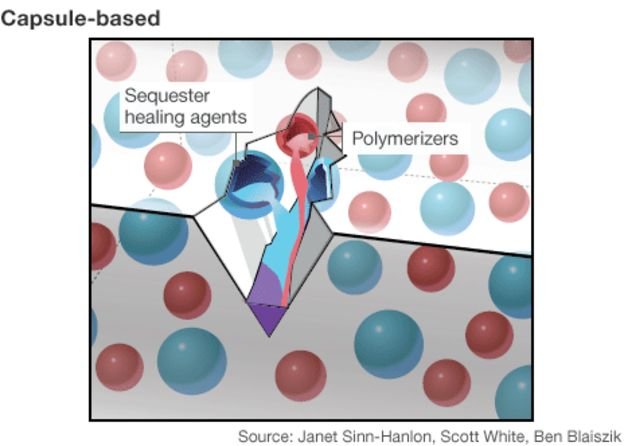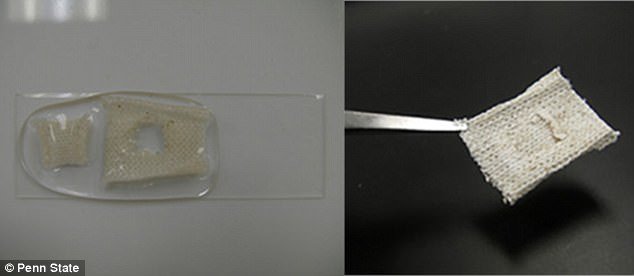
Materials that can heal themselves?! It sounds like a science-fiction gadget, but it's already happening!
A while ago, I posted about Smartphone screens that could heal themselves - today, I want to share some other amazing materials that can stitch themselves back together, whether that's rubber, fabric or plastic.
1) Self-healing plastic
Researchers from the University of Illinois are currently working on self-healing plastics and paints.
The idea here is that a healing agent, which is basically just tiny packets of specialized glue, is being added to the plastic. And once the plastic cracks, the packets of glue will split open and spill out the special glue.
Now the problem with this technology is that glue usually needs water or air to cure. But since this material should be able to heal itself without the need for water or air, scientists have come up with the idea to add another chemical to make the glue cure on its own.

This new healing agent is called HOPDMS, which is made up of long chains of molecules, called Polymers.
On each end of these polymers, there is a pair of hydrogen and oxygen, called a hydroxyl group.
Then, the scientists added a second chemical called DMDNT in tiny packets, which acts as the curing agent.
So again, when the plastic breaks, the packets open, the chemicals mix and the glue fixes the crack and cures.
The DMDNT reacts with the HOPDMS, breaking off the Hydroxyl group from one end of each chain so that the chains can bond together.
A single molecule of DMDNT can actually attach thousands of polymers!
The newly formed, longer polymers now get tangled into knots, which keeps the molecules from moving around freely. And this is what turns the healing agent into a solid.

The researchers were even able to turn this self-healing plastic coating into paint. They conducted an experiment to see if the coating could prevent rust.
So they painted a piece of steel with this specialized paint, then cracked the coating by scratching it with a razor blade, allowing it some time to heal and then put the piece of steel in salt water.
When they took it out again, it was rust-free, just like they imagined - the experiment was a success!
2) Self-healing fabric
A team from the Pennsylvania State University has created a revolutionary new fabric that can stich itself back together once submerged into water.
The technology works by applying a coating of polyelectrolytes to the fabric, which consist of positively and negatively charged polymers.
Once the fabric is coated with these charged chains of molecules, it is then submerged in water and slightly pressed together.
When emerged, the fabric actually stitched itself back together and comes out as one flexible, sturdy piece!

"We were looking for a way to make fabrics self-healing using conventional textiles. So we came up with this coating technology. We currently dip the whole garment to create the advanced material, but we could do the threads first, before manufacturing if we wanted to. (...) If you need to use enzymes for biological or chemical effects, you can have an encapsulated enzyme with self-healing properties degrade the toxin before it reaches the skin. (...) The coatings are thin, less than a micron, so they wouldn’t be noticed in everyday wear. Although thin, they increase the overall strength of the material. For the first time we ae making self-healing textiles!"-Melik C. Demirel, professor of engineering science and mechanics
3) Self-healing tires
A team of scientists from the Leibniz Institute of Polymer Research created a specific form of rubber that can heal itself. If you cut it and then hold the 2 pieces together, they will reattach!
Imagine creating tires for cars or trucks that could fix themselves - wouldn't that be amazing ?
Tires are not only made of rubber - they have Sulfur added to them to strengthen the molecular bonds.
Now instead of adding Sulfur to the rubber, the scientists added a pair of charged molecules: Butyl Imidazolium (positive charge) and Bromide (negative charge).
These ion pairs tend to form big groups by bonding to other pairs.
So an ion pair will stick to one rubber molecule, and then bond to another rubber molecule, forming ionic bonds which make the material stronger.
And here's the catch: ionic bonds can easily reform after being snapped, so when cutting through this specific rubber, the ionic bonds are able to bond again!
Keep in mind that the two pieces of rubber need to be held together though.
To speed up the "healing" process, the scientists added heat - but now, they're working on perfecting the process so that the rubber will be able to heal itself rather quickly without any additional heat.

What other uses are there for self-healing materials? Let me know what you think would be the best innovation!
Steemit Cover Logo by @rubenalexander, Images: 1, 2, 3, 4, 5, Sources: 1, 2, 3, 4, 5
- Instagram -

© Sirwinchester


